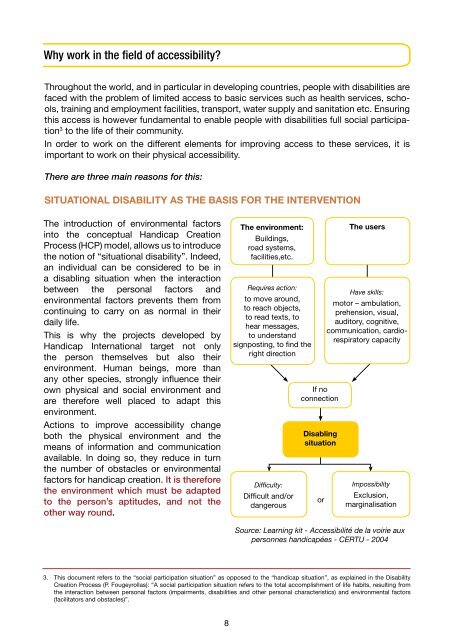Accessibility - Handicap International
Accessibility - Handicap International
Accessibility - Handicap International
Create successful ePaper yourself
Turn your PDF publications into a flip-book with our unique Google optimized e-Paper software.
Why work in the field of accessibility?<br />
Throughout the world, and in particular in developing countries, people with disabilities are<br />
faced with the problem of limited access to basic services such as health services, schools,<br />
training and employment facilities, transport, water supply and sanitation etc. Ensuring<br />
this access is however fundamental to enable people with disabilities full social participation<br />
3 to the life of their community.<br />
In order to work on the different elements for improving access to these services, it is<br />
important to work on their physical accessibility.<br />
There are three main reasons for this:<br />
SITUATIONAL DISABILITY AS THE BASIS FOR THE INTERVENTION<br />
The introduction of environmental factors<br />
into the conceptual <strong>Handicap</strong> Creation<br />
Process (HCP) model, allows us to introduce<br />
the notion of “situational disability”. Indeed,<br />
an individual can be considered to be in<br />
a disabling situation when the interaction<br />
between the personal factors and<br />
environmental factors prevents them from<br />
continuing to carry on as normal in their<br />
daily life.<br />
This is why the projects developed by<br />
<strong>Handicap</strong> <strong>International</strong> target not only<br />
the person themselves but also their<br />
environment. Human beings, more than<br />
any other species, strongly influence their<br />
own physical and social environment and<br />
are therefore well placed to adapt this<br />
environment.<br />
Actions to improve accessibility change<br />
both the physical environment and the<br />
means of information and communication<br />
available. In doing so, they reduce in turn<br />
the number of obstacles or environmental<br />
factors for handicap creation. It is therefore<br />
the environment which must be adapted<br />
to the person’s aptitudes, and not the<br />
other way round.<br />
The environment:<br />
Buildings,<br />
road systems,<br />
facilities,etc.<br />
Requires action:<br />
to move around,<br />
to reach objects,<br />
to read texts, to<br />
hear messages,<br />
to understand<br />
signposting, to find the<br />
right direction<br />
Difficulty:<br />
Difficult and/or<br />
dangerous<br />
If no<br />
connection<br />
Disabling<br />
situation<br />
or<br />
The users<br />
Have skills:<br />
motor – ambulation,<br />
prehension, visual,<br />
auditory, cognitive,<br />
communication, cardiorespiratory<br />
capacity<br />
Impossibility<br />
Exclusion,<br />
marginalisation<br />
Source: Learning kit - Accessibilité de la voirie aux<br />
personnes handicapées - CERTU - 2004<br />
3. This document refers to the “social participation situation” as opposed to the “handicap situation”, as explained in the Disability<br />
Creation Process (P. Fougeyrollas): “A social participation situation refers to the total accomplishment of life habits, resulting from<br />
the interaction between personal factors (impairments, disabilities and other personal characteristics) and environmental factors<br />
(facilitators and obstacles)”.<br />
8

















